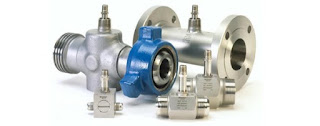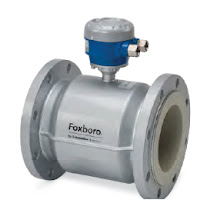The Flowserve Limitorque MX actuator controls the opening and closing travel of valves and other actuated devices. OPEN and CLOSED limits are protected by an absolute encoder that provides optical sensing of valve position and measures valve position in both motor and handwheel operation.
No battery or backup power supply is required. Output torque is derived from motor speed, temperature, and voltage. If the preset torque is exceeded, the motor shuts off. As a result of this reliable and advanced protection technology, all valve and other actuated devices are protected from potential damage from overload, improper seating, and foreign obstructions.
A range of control and network options is available and can be easily added to the control capabilities already available on a standard actuator.
You can download the Limitorque MX Electronic Actuator User Instructions, Maintenance, and Spare Parts Manual in PDF version from the Swanson Flo site here (8.5MB), or read the embedded version below.

The Swanson Flo Blog is dedicated to provide educational and new product information on process control instrumentation, control valves, and valve automation. For more information on these products, visit SwansonFlo.com or call 800-288-7926.
Limitorque MX Actuator Users Instructions, Maintenance, and Spare Parts Manual
Posted by
Swanson Flo
Labels:
electric actuator,
Flowserve,
Illinois,
Indiana,
Iowa,
Limitorque,
Michigan,
Minnesota,
Montana,
Nebraska,
North Dakota,
South Dakota,
valve automation,
Wisconsin,
Wyoming
Turbine Flow Meters
 |
| Turbine flow meters (Badger Meter / Blancett) |
Turbine flow meters use the mechanical energy of the fluid to rotate a turbine blade in the flow stream and provide precise and accurate flow measurement. The flow impinging upon the turbine blades causes the rotor to spin. The angular velocity of a turbine flow meter is proportional to flow rate. The rotational velocity of the turbine is interpreted as an electrical frequency output through the use of magnetic pick-ups. As each turbine blade passes by the magnetic pick-up coil, a voltage pulse is generated which is a measure of the flow rate. The total number of pulses gives a measure of the total flow which can be totalized with a maximum error of a single pulse.
The relationship of the angle of the turbine meter blades to the flow stream governs the angular velocity and the output frequency of the meter. The sharper the angle of the turbine blade, the higher the frequency output.
Easy to maintain while also boasting reliability, turbine flow meters are known to be cost-effective solutions that make an ideal device for measuring flow rate. Aside from excellent rangeability, they also provide high response rate and high accuracy compared to other available types of flow meters. Turbine flow meters are sturdy, need very little maintenance, and seldom exhibit much deviation in performance.
 |
| Turbine flow meters (Hoffer Flow Controls) |
Advantages:
- Accuracy
- Excellent repeatability and range
- External power not required
- Good fro cryogenic applications
- Good for extreme pressures and temperatures
- Easy to install
- Material availability
- Not recommended for contaminated media or slurries
- Error due to wear
Posted by
Swanson Flo
Labels:
Badger,
Blancett,
flow control,
Hoffer,
Illinois,
Indiana,
Iowa,
Michigan,
Minnesota,
Montana,
Nebraska,
North Dakota,
South Dakota,
turbine flow meter,
Wisconsin,
Wyoming
Disassembly, Repair, and Rebuild of the Jordan Mark 78 Control Valve
The Jordan Mark 78 pneumatic control valve is designed for accurate performance and simplified maintenance. This versatile product can be used on a variety of applications, including viscous/corrosive liquids, process gases or steam in process or utility service.
- Shutoff: ANSI Class IV or VI
- Sizes: 1/2" – 2" (DN15 – DN50)
- End Connections: Threaded, Flanged, Socket Weld, Butt-Weld
- Body Materials: Bronze, Carbon Steel, Stainless Steel
- Cv (Kv): up to 50 (up to 43)
- Trim Materials: Stainless Steel, Monel, Hastelloy C, Alloy 20
- Seat: ANSI Class IV (Hard Seat); ANSI Class VI Teflon (Soft Seat)
- Control Ranges: 3-15 psi, 6-30 psi or split ranges (0,2-1,0 bar, 0,4-2,1 bar)
The video below provides a detailed demonstration of how to disassemble, repair, and rebuild the Mark 78 control valve.
800-288-7926
Posted by
Swanson Flo
Labels:
Control Valve,
Illinois,
Indiana,
Iowa,
Jordan,
Mark 78,
Michigan,
Minnesota,
Montana,
Nebraska,
North Dakota,
South Dakota,
Wisconsin,
Wyoming
Understanding Explosion Proof Enclosures Used in Process Control
This is a short video that explains what an explosion-proof enclosure is, what defines it as “explosion-proof”, and the principle behind why its safe to use in explosive or combustible atmospheres.
“Explosion-proof" doesn't mean the enclosure can withstand the forces of an external explosion. It means that the enclosure is designed to cool any escaping hot gases (caused by an internal ignition) sufficiently enough as to prevent the ignition of combustible gases or dusts in the surrounding area.
https://swansonflo.com
800-288-7926
“Explosion-proof" doesn't mean the enclosure can withstand the forces of an external explosion. It means that the enclosure is designed to cool any escaping hot gases (caused by an internal ignition) sufficiently enough as to prevent the ignition of combustible gases or dusts in the surrounding area.
https://swansonflo.com
800-288-7926
Posted by
Swanson Flo
Labels:
Illinois,
Indiana,
Iowa,
Michigan,
Minnesota,
Montana,
Nebraska,
North Dakota,
process control,
South Dakota,
what does explosion proof mean,
Wisconsin,
Wyoming
Introduction to Industrial Control Systems
 Control systems are computer-based systems that are used by many infrastructures and industries to monitor and control sensitive processes and physical functions. Typically, control systems collect sensor measurements and operational data from the field, process and display this information, and relay control commands to local or remote equipment. In the electric power industry they can manage and control the transmission and delivery of electric power, for example, by opening and closing circuit breakers and setting thresholds for preventive shutdowns. Employing integrated control systems, the oil and gas industry can control the refining operations on a plant site as well as remotely monitor the pressure and flow of gas pipelines and control the flow and pathways of gas transmission. In water utilities, they can remotely monitor well levels and control the wells’ pumps; monitor flows, tank levels, or pressure in storage tanks; monitor water quality characteristics, such as pH, turbidity, and chlorine residual; and control the addition of chemicals. Control system functions vary from simple to complex; they can be used to simply monitor processes—for example, the environmental conditions in a small office building—or manage most activities in a municipal water system or even a nuclear power plant.
Control systems are computer-based systems that are used by many infrastructures and industries to monitor and control sensitive processes and physical functions. Typically, control systems collect sensor measurements and operational data from the field, process and display this information, and relay control commands to local or remote equipment. In the electric power industry they can manage and control the transmission and delivery of electric power, for example, by opening and closing circuit breakers and setting thresholds for preventive shutdowns. Employing integrated control systems, the oil and gas industry can control the refining operations on a plant site as well as remotely monitor the pressure and flow of gas pipelines and control the flow and pathways of gas transmission. In water utilities, they can remotely monitor well levels and control the wells’ pumps; monitor flows, tank levels, or pressure in storage tanks; monitor water quality characteristics, such as pH, turbidity, and chlorine residual; and control the addition of chemicals. Control system functions vary from simple to complex; they can be used to simply monitor processes—for example, the environmental conditions in a small office building—or manage most activities in a municipal water system or even a nuclear power plant. In certain industries such as chemical and power generation, safety systems are typically implemented to mitigate a disastrous event if control and other systems fail. In addition, to guard against both physical attack and system failure, organizations may establish back-up control centers that include uninterruptible power supplies and backup generators.
In certain industries such as chemical and power generation, safety systems are typically implemented to mitigate a disastrous event if control and other systems fail. In addition, to guard against both physical attack and system failure, organizations may establish back-up control centers that include uninterruptible power supplies and backup generators.There are two primary types of control systems. Distributed Control Systems (DCS) typically are Supervisory Control and Data Acquisition (SCADA) systems typically are used for large, geographically dispersed distribution operations. A utility company may use a DCS to generate power and a SCADA system to distribute it.
 |
| Field devices and discreet controllers used in control systems (Foxboro Schneider Electric). |
Swanson Flo can help you with control system questions or challenges. Reach them by calling 800-288-7926 or visiting https://swansonflo.com.
Posted by
Swanson Flo
Labels:
control system,
Foxboro,
Illinois,
Indiana,
Iowa,
Michigan,
Minnesota,
Montana,
Nebraska,
North Dakota,
process control,
Schneider Electric,
South Dakota,
Wisconsin,
Wyoming
Foxboro Magnetic Flowmeter for Chemical and Process Industries
With a wide range of liners and electrodes, the 9700A owtube is ideal for the Chemical and Process industries. In combination with the IMT30A, IMT31A and IMT33A transmitters, Foxboro offers an innovative solution designed to meet the demands for all chemical applications such as:
- Clean liquids
- Mixing of chemicals
- Demanding applications including corrosive, abrasive liquids • Rapid variation of the pH value
- For slurries and pastes with high solids content
- Drilling applications, mining slurries with large particles
See the embedded brochure below, or download your own PDF from this Swanson Flo link.
Butterfly Valves Used in Industrial and Commercial Applications
 |
| Automated butterfly control valve. (Valtek) |
A butterfly valve is used for stopping or controlling flow of liquids or materials through pipes. The "butterfly" refers to the round, flat disk that allows for flow through the valve. Butterfly valves are a member of the "quarter-turn" valve family, meaning fully open to fully closed in 90 degrees rotation. They are opened and closed via a lever, manual gear operator, pneumatic actuator, or electric actuator. Butterfly valves can be used for on-off service and some varieties are used as control valves. Butterfly valves are generally less expensive than other high flow valves, lighter in weight, and take up less piping length. Since the disk is always in the flow path, butterfly valves always have a pressure drop across the valve.
There are two primary types of butterfly classifications:
- So called "rubber lined" butterfly valves (resilient seated) which are best suited for lower pressure, lower temperature, general purpose applications.
- High Performance Butterfly Valves (HPBV) which are designed to ANSI pressure classifications and are suited for more robust industrial applications.
 |
| Rubber lined butterfly valve. (Centerline) |
High performance butterfly valves have precision machined teflon, or metal seats, and are slightly offset as to lessen the amount of seat-to-disk interference. The disc still is pushed against he seat, but in a much more controlled and measured manner. Seat wear is still an issue, but not like rubber lined valves. Seating and unseating torque effects are much less as well.
 |
| Triple offset butterfly. (Valtek) |
Butterfly valves come in three body styles:
- Wafer body, whereby the valve is "sandwiched" and held in place between two pipe flanges and are suitable for lower pressure applications.
- Lug style bodies that have threaded "lugs" cast in to the body of the valve and bolts are used to secure the valve for end of line service or keeping the valve in place when the piping is disassembled.
- ASME flanged butterfly valves where the valve body is in-between two ASME flanges.
Posted by
Swanson Flo
Labels:
butterfly valve,
high performance butterfly,
Illinois,
Indiana,
Iowa,
Michigan,
Minnesota,
Montana,
Nebraska,
North Dakota,
resilient seated,
rubber lined,
South Dakota,
Wisconsin,
Wyoming
Subscribe to:
Comments (Atom)


